History of Pennsylvania facts for kids
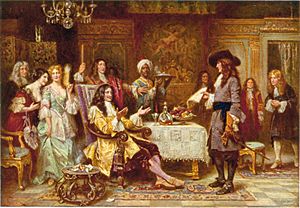
The history of Pennsylvania began thousands of years ago with the first Native American tribes living in the area. These included the Lenape, Susquehannocks, Iroquois, Erie, and Shawnee peoples.
Europeans first arrived when the Dutch settled parts of the area in 1643. Later, the English took control. In 1681, William Penn received a special document from King Charles II, making Pennsylvania an English colony.
William Penn was a Quaker, a religious group that believed in peace and equality. He wanted his colony to be a place where people of all faiths could live freely. Many Quakers, Germans, and Scots-Irish immigrants moved to Pennsylvania. Sadly, many Native American tribes faced hardship and lost their lands due to illnesses and conflicts.
Pennsylvania, especially its largest city, Philadelphia, played a huge role in the American Revolution. This was where important plans were made to challenge King George III and Great Britain. Philadelphia even served as the capital of the new United States for a time.
In the 1800s, Pennsylvania's borders were set, and Pittsburgh grew into a major city. The state was very important during the American Civil War, helping the Union win. After the war, Pennsylvania became a strong center for manufacturing and transportation.
By the 1900s, after big events like the Great Depression and World War II, Pennsylvania's economy changed. It moved from mostly farming and factories to more service and financial jobs. Politically, it became a "swing state," meaning it could vote for either major party.
Contents
- Early Native American Life in Pennsylvania
- European Colonization of Pennsylvania
- The Province of Pennsylvania
- Pennsylvania and the American Revolution
- Pennsylvania's Westward Expansion
- Pennsylvania in the 19th Century
- Pennsylvania During the Civil War
- Pennsylvania in the Late 19th and Early 20th Centuries
- Pennsylvania in the Mid-20th Century
- Pennsylvania in the Late 20th and Early 21st Centuries
- Pennsylvania's Major Cities Today
- See also
Early Native American Life in Pennsylvania
First People and Their Ways of Life
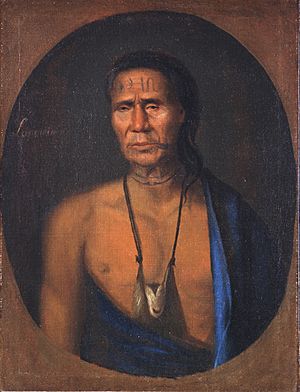
Long before Europeans arrived, people lived in the area we now call Pennsylvania. Scientists believe the first people came to North America over 15,000 years ago. The oldest known signs of human life in Pennsylvania are found at the Meadowcroft Rockshelter. This site shows that people lived here more than 10,000 years ago!
These early people were hunter-gatherers, meaning they hunted animals and gathered plants for food. By about 1000 C.E., Native American tribes in Pennsylvania had learned to farm. They grew crops and had a varied diet.
Major Native American Tribes
When Europeans first came, several important Native American tribes lived in Pennsylvania. The Lenape tribe spoke an Algonquian language. Their lands, called Lenapehoking, covered eastern Pennsylvania and much of New Jersey.
The Susquehannock tribe spoke an Iroquoian language. Their territory stretched from New York to West Virginia, including areas near the Susquehanna River and what is now Pittsburgh.
Other tribes, like the Iroquois and Erie, also lived in or moved through the region. These tribes had their own cultures, languages, and ways of life.
Changes After European Arrival
The arrival of Europeans brought big changes for Native American tribes. New illnesses caused many people to get sick and die. There were also many conflicts and wars, such as the Beaver Wars, which changed tribal territories and power.
Many tribes lost their lands and were forced to move. For example, the Lenape were relocated to areas like Ohio after agreements like the Walking Purchase. The Monongahela culture in southwestern Pennsylvania also faced huge losses and nearly disappeared.
Despite these challenges, Native American history is a vital part of Pennsylvania's story. Their traditions and contributions continue to be important today.
European Colonization of Pennsylvania
Early European Explorers and Traders
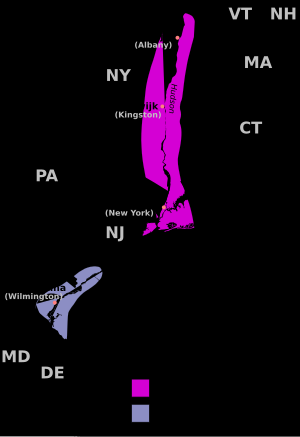
European explorers began visiting North America after Christopher Columbus's voyage in 1492. In 1524, the French explorer Giovanni da Verrazzano mapped the Pennsylvania area, calling it "L'arcadia," meaning "wooded coast."
Even before many Europeans settled, Native American tribes traded with them. The fur trade was a big reason Europeans wanted to explore and settle here. This trade also led to wars among Native American tribes, like the Beaver Wars.
Dutch, Swedish, and British Settlements
In the 1600s, several European countries wanted control of southeastern Pennsylvania. The Dutch, Swedish, and British all competed for the land. The French also moved into western Pennsylvania.
In 1638, the Kingdom of Sweden created the colony of New Sweden. Its capital was at Fort Christina (near Wilmington, Delaware). In 1643, the first European settlement in Pennsylvania was built by the Swedes at Fort Nya Gothenburg on Tinicum Island.
The Dutch Republic also had a colony called New Netherland. In 1655, the Dutch took over New Sweden. Even though Sweden no longer controlled the land, Swedish and Finnish settlers stayed. They brought with them America's first log cabins.
The Kingdom of England also claimed the area. During the Second Anglo-Dutch War (1665–1667), the English took control of the Dutch and former Swedish lands in North America. By 1674, England's control of the region was permanent.
French Influence in Western Pennsylvania
The French also established a colony called New France in the 1600s. They expanded into the Great Lakes region and the Mississippi River area. By the 1700s, New France reached into western Pennsylvania. The French built Fort Duquesne to protect their interests near what is now Pittsburgh.
France and England often fought for control of North America. These conflicts, known as the French and Indian Wars, lasted until 1763. After their defeat, France lost New France, and Britain gained control of more land, including Pennsylvania's frontier.
The Province of Pennsylvania
William Penn's Vision for a Colony
On March 4, 1681, Charles II of England gave William Penn a large piece of land. This was to pay a debt the king owed Penn's father. Penn, a Quaker, wanted to create a colony where people could practice their religion freely.
King Charles II named the colony Pennsylvania, meaning "Penn's woods" in Latin. William Penn was a bit embarrassed, fearing people would think he named it after himself. In October 1682, Penn arrived in North America and founded Philadelphia, which became the capital of the colony.
A Home for Many Cultures
Pennsylvania became known for its religious tolerance. This attracted many different groups of people seeking freedom. Welsh Quakers settled lands near Philadelphia. Many towns in this "Welsh Tract" were named after places in Wales.
The colony also welcomed German, Scots-Irish, Scots, and French settlers. Many of these groups, like Huguenots, Mennonites, and Catholics, came to escape persecution in their home countries. Anglicans and Jews also moved to Pennsylvania. By 1730, there was also a significant African-American population.
Native American tribes continued to live in the area under their own rules. Settlers from the earlier Swedish and Dutch colonies also remained.
Government and Growth
To give his colony access to the ocean, Penn also gained control of the "three lower counties" along the Delaware River, which are now the state of Delaware. Pennsylvania and Delaware shared the same governor until the American Revolutionary War.
William Penn passed away in 1718. His sons took over as leaders of the colony. While Penn had good relationships with the Lenape tribe, his sons were less understanding. The 1737 Walking Purchase expanded the colony but worsened relations with the Lenape.
Philadelphia grew into an important port and trading center. The University of Pennsylvania was founded, and Benjamin Franklin started many important organizations. By the start of the American Revolution, Philadelphia was the largest city in British North America.
French and Indian War Conflicts
Western Pennsylvania was a disputed area between the British and French. The French built forts like Fort Duquesne near present-day Pittsburgh to protect their land. Many Native American tribes sided with the French due to their long trading history.
The conflict began in 1754 when George Washington led a Virginia militia against French forces. This led to the Battle of Jumonville Glen and the Battle of Fort Necessity. The British eventually sent larger forces, and after several battles, the French destroyed Fort Duquesne and left the area in 1758.
Britain's victory in the French and Indian War in 1763 secured Pennsylvania's western frontier. However, the French later helped the American rebels during the American Revolution.
Native American Resistance and the Proclamation of 1763
During the French and Indian War, settlers in Pennsylvania faced attacks from Native American allies of the French. After the war, Native Americans tried to push the British out of the Ohio country in Pontiac's Rebellion, with heavy fighting in western Pennsylvania.
The British defeated the native forces in the Battle of Bushy Run. The war ended in 1766. During this time, the king issued the Royal Proclamation of 1763. This law stopped Americans from settling west of the Appalachian Mountains, reserving that land for Native Americans.
Native American tribes stopped being a military threat to European settlers in Pennsylvania after the Northwest Indian War ended in 1795.
Pennsylvania and the American Revolution
Steps Towards Independence
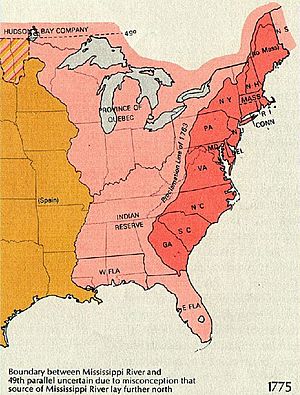
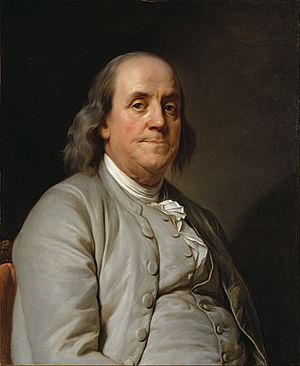
Pennsylvania residents joined other colonies in protesting British policies after 1763. The colony sent delegates to the Stamp Act Congress in 1765. Philadelphia became a central meeting place, hosting the First Continental Congress and the Second Continental Congress.
At Independence Hall in Philadelphia, the Second Continental Congress created the Continental Army and chose George Washington as its leader. On July 4, 1776, they officially adopted the Declaration of Independence. This document declared the colonies' freedom from Great Britain and intensified the American Revolutionary War.
Battles and Winter at Valley Forge
Pennsylvania was the site of many important battles during the Revolutionary War. These included George Washington's crossing of the Delaware River, the Battle of Brandywine, and the Battle of Germantown.
During the winter of 1777–78, General George Washington's army stayed at Valley Forge, Pennsylvania. This was a very difficult time for the soldiers, but they emerged stronger.
In 1781, the Articles of Confederation (America's first constitution) were written and adopted in York, Pennsylvania. Philadelphia continued to be the nation's capital until 1783.
New State and Federal Constitutions
In 1780, Pennsylvania passed a law for the gradual end of slavery. This made Pennsylvania one of the first states to take steps to abolish slavery. Children born to enslaved mothers after this date were considered free, though they had to work for their mother's master until age 28.
In 1787, delegates from across the country met in Philadelphia to write a new constitution. Pennsylvania was the second state to approve the U.S. Constitution on December 12, 1787.
After the new Constitution was approved, George Washington became the first President in 1789. Philadelphia served as the nation's capital again from 1790 to 1800, before Washington, D.C. was built. In 1790, Pennsylvania also adopted a new state constitution, creating a governor and a two-house legislature.
Pennsylvania's Westward Expansion
Defining Borders and New Lands
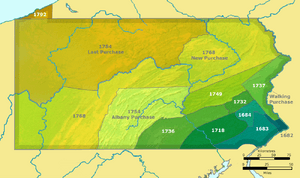
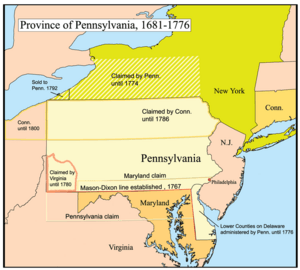
Pennsylvania's borders were finalized around the time of the Revolutionary War. The Mason–Dixon line set the border with Maryland and Virginia. Through treaties like the Treaty of Fort Stanwix, Native American tribes gave up claims to lands in southwestern and northwestern Pennsylvania.
In 1792, Pennsylvania bought the Erie Triangle from the federal government. This gave the state access to Lake Erie. Conflicts over land, like the Pennamite–Yankee War with Connecticut settlers, also ended, confirming Pennsylvania's control of the Wyoming Valley.
Land Sales and the Whiskey Rebellion
After the Revolutionary War, the U.S. government gave land to soldiers. Pennsylvania also sold large amounts of land to encourage settlement. This led to land speculation, where people bought land hoping its value would increase.
The Whiskey Rebellion (1791–1794) was a major challenge to the new federal government. Farmers in Western Pennsylvania rebelled against a tax on distilled spirits. In 1794, President George Washington led a large militia to stop the rebellion. Most rebels went home before the army arrived.
Pennsylvania in the 19th Century
Political Landscape and Key Figures
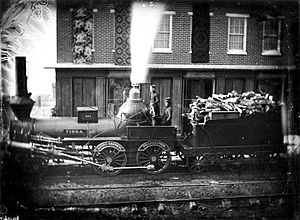
Pennsylvania was one of the largest states and had many electoral votes for presidential elections. For much of the 1800s, the state often supported the Democratic-Republican and later the Democratic parties.
Many Pennsylvanians became important national figures. Frederick Muhlenberg was the first Speaker of the U.S. House of Representatives. Albert Gallatin served as Secretary of the Treasury. James Buchanan, from Pennsylvania, became President of the United States in 1857.
War of 1812 and Urban Growth
Pennsylvanians played a role in the War of 1812. Stephen Decatur was a naval hero. Oliver Hazard Perry built a fleet at Erie, Pennsylvania and won the Battle of Lake Erie.
Philadelphia remained one of the country's largest cities. It was home to the first stock exchange, museum, and medical school in the new nation. The Academy of Natural Sciences of Philadelphia and the Franklin Institute were also founded there.
Western Development and Education
Settlers continued to move west across the Allegheny Mountains. New roads, like the National Road, were built. Pennsylvania also saw the construction of thousands of miles of railroads, with the Pennsylvania Railroad becoming one of the largest.
Pittsburgh grew into an important city in western Pennsylvania. In 1834, the Main Line of Public Works, a system of railroads and canals, connected Philadelphia and Pittsburgh. In 1812, Harrisburg became the state capital.
Agriculture was very important, making Pennsylvania the largest food producer in the country by the 1720s. Farming remained a major industry throughout the 1800s.
In 1834, the Free Schools Act created a system of state-regulated public schools. The Department of Education was established to oversee these schools. In 1857, normal schools were created to train teachers.
Pennsylvania During the Civil War
A Divided State and Key Battles
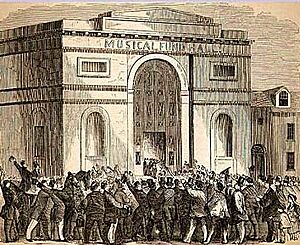
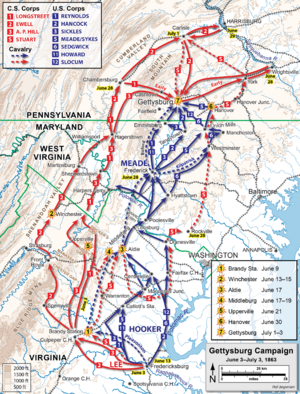
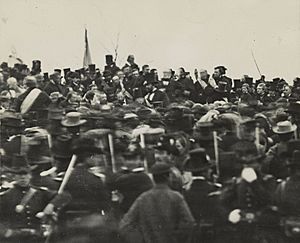
Before and during the American Civil War, Pennsylvania was divided. Although slavery was outlawed in the state, some Pennsylvanians believed the federal government should not interfere with slavery in other states.
The Republican Party held its first national convention in Philadelphia in 1856. In the 1860 election, Republicans won the state's presidential vote and the governor's office.
When the Civil War began, Pennsylvania was a key member of the Union. The state was attacked several times by the Confederate States Army. Confederate cavalry raided in 1862 and 1863, and Chambersburg was burned in 1864.
The most famous battle in Pennsylvania was the Battle of Gettysburg in July 1863. This was a major turning point in the war and the bloodiest battle, with tens of thousands of casualties. The Union victory here marked the "high water mark of the Confederacy." President Abraham Lincoln later gave his famous Gettysburg Address at the Gettysburg National Cemetery.
Pennsylvania's Leaders in the War
Pennsylvania leaders like Thaddeus Stevens were important Radical Republicans. They wanted to win the war, end slavery, and protect the rights of African Americans.
Many Pennsylvania generals served bravely, including George G. Meade, who led the Union army at Gettysburg. Governor Andrew Curtin strongly supported the war effort.
Pennsylvania in the Late 19th and Early 20th Centuries
Republican Dominance and Progressive Reforms
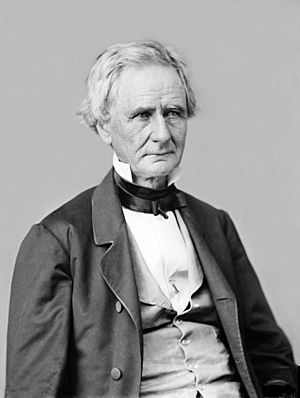
After the Civil War, the Republican Party became very powerful in Pennsylvania politics. They won almost every election for decades. Pennsylvania's large number of electoral votes helped Republicans win many presidential elections.
Powerful Republican leaders, like Simon Cameron and Matthew Quay, controlled the state party. However, there was also a reform movement. Many Pennsylvanians supported the Progressive movement, which aimed to improve society and government. New state agencies, like the Department of Welfare, were created.
Pennsylvania twice rejected giving women the right to vote through state amendments. However, it was one of the first states to ratify the Nineteenth Amendment in 1920, which gave women the right to vote nationwide.
Industrial Growth and Labor Movements
The period after the Civil War, known as the Gilded Age, saw huge growth in Pennsylvania's industries. The state became home to some of the world's largest steel companies, founded by people like Andrew Carnegie and Charles M. Schwab.
The U.S. oil industry began in western Pennsylvania in the late 1800s. Towns like Titusville boomed with the oil rush. Coal mining was also a major industry.
The growth of industries created many jobs but also led to challenges for workers. Labor unions formed to fight for better wages and working conditions. Pennsylvania saw major strikes, including the Great Railroad Strike of 1877 and the Coal Strike of 1902. Eventually, the eight-hour workday was adopted.
Immigration and Innovation
Millions of immigrants came to the United States during this time, many from southern and eastern Europe. Pennsylvania, especially its cities and industrial areas, welcomed many of these new arrivals. They found jobs in factories, steel mills, and coal mines. These immigrants and their families helped shape the state's diverse culture.
Pennsylvania was also a center of scientific discovery and innovation. Pennsylvanians invented important things like iron bridges, air brakes, and switching signals for railroads. George Westinghouse in Pittsburgh became a famous inventor. Philadelphia became a leading center for medical science.
Education Advances
Education continued to be important. In 1895, school attendance became mandatory. By 1903, school districts had to provide high schools or pay for students to attend one.
The Pennsylvania State University was founded in 1855. Temple University in Philadelphia was started in 1884 as a night school for working adults. Many other colleges and universities were also established during this period.
Pennsylvania played a vital role in World War I, providing over 300,000 soldiers and serving as an important industrial center.
Pennsylvania in the Mid-20th Century
Great Depression and World War II
The Great Depression in the 1930s changed Pennsylvania's political landscape. Democrat Franklin D. Roosevelt won the state's electoral votes in all his re-election campaigns, the first Democrat to do so since 1856.
Pennsylvania suffered greatly during the Great Depression due to its large industrial workforce. The state passed its own "Little New Deal" reforms.
During World War II, Pennsylvania was a crucial manufacturing hub, producing a significant portion of U.S. military equipment. The Philadelphia Naval Yard was an important base. Over one million Pennsylvanians served in the United States Armed Forces, and many received the Medal of Honor. Important military leaders like George Marshall and Henry H. Arnold were from Pennsylvania.
Pennsylvania in the Late 20th and Early 21st Centuries
Changing Politics and Economy

After World War II, the Republican Party's strong hold on Pennsylvania politics lessened. Pennsylvania adopted its current constitution in 1968, which allowed governors to serve two terms.
Pennsylvania became an important "swing state" in national elections. Democrats often win in cities, Republicans in rural areas, and the suburbs often decide statewide elections.
The state's economy changed as the steel and other heavy industries declined in the late 20th century. This led to job losses and population decreases in cities like Philadelphia and Pittsburgh. Pennsylvania shifted towards service industries, healthcare, retail, transportation, and tourism. Pittsburgh, with its universities, became a leader in technology and healthcare.
New immigrant groups, especially Hispanic communities, moved to Pennsylvania. They filled jobs in agriculture and service industries, bringing their cultures and languages. For example, Puerto Ricans built a large community in Allentown.
September 11, 2001, and Flight 93
On September 11, 2001, during the terrorist attacks on the United States, United Airlines Flight 93 crashed into a field in Stonycreek Township, near the small town of Shanksville, Pennsylvania.
The passengers on board learned about the other attacks and bravely fought back against the hijackers. Their heroic actions prevented the plane from reaching its intended target in Washington, D.C., and saved many lives. The site is now a memorial to their courage.
Pennsylvania's Major Cities Today
Philadelphia is the nation's sixth-largest city and the center of the Delaware Valley metropolitan area. It is a core population center in the Northeastern United States.
Pittsburgh is the state's second-largest city and the center of the Greater Pittsburgh metropolitan area. It is part of the Great Lakes Megalopolis.
Other important metropolitan areas in Pennsylvania include the Lehigh Valley. Both Allentown and Pittsburgh are part of the "Rust Belt," a region that faced economic challenges when heavy industries declined. However, these cities have seen significant revitalization in recent years.
See also
- Education in Pennsylvania
- History of Erie, Pennsylvania
- History of Harrisburg, Pennsylvania
- History of the Mid-Atlantic States
- History of the Northeastern United States
- History of Philadelphia
- History of Pittsburgh
- History of slavery in Pennsylvania
- History of the Townships of Lycoming County, Pennsylvania
- History of West Chester, Pennsylvania
- History of Williamsport, Pennsylvania
- Jewish history in Pennsylvania
- List of historical Pennsylvania women
- List of historical societies in Pennsylvania
- List of newspapers in Pennsylvania in the 18th-century
- List of Pennsylvania suffragists
- Pennsylvania Historical and Museum Commission
- Pennsylvania Woman's Convention at West Chester in 1852
- Timeline of Philadelphia
- Timeline of Pittsburgh
- Women's suffrage in Pennsylvania





